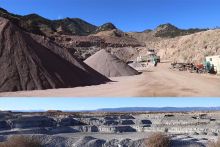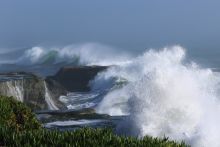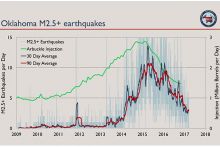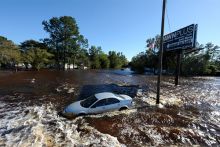This free webinar, featuring two Geoscientists without Borders® (GWB) humanitarian projects, provides information about the challenges and ways forward for implementing hazard early warning systems in data sparse locations to protect vulnerable populations. Our speakers will discuss geophysical methods carried out to build a robust database aimed at predicting natural disasters, such as landslides and earthquakes, ultimately to improve existing models and advance warning times for populations in high-risk hazard locations.
View the next video in this webinar
Our speakers
- Dr. Václav Kuna, Postdoctoral Researcher, Institute of Geophysics, Czech Academy of Sciences
NepalEEW: Testing the feasibility of an Earthquake Early Warning System in Nepal Video |
Video | ![]() Abstract |
Abstract | ![]() Presentation slides
Presentation slides
- Dr. Thomas Oomen, Professor of Geological Engineering, Director of Computational Science and Engineering PhD Program, Michigan Technological University
Landslide Early Warning in a Data Sparse Region, Challenges and Way Forward: The case of Idukki, Western Ghats, India Video |
Video | ![]() Abstract |
Abstract | ![]() Presentation slides
Presentation slides
Additional resources
The above GWB projects help address United Nations Sustainable Development Goals (UNSDGs) SDG 9 (Industry, Innovation and Infrastructure), SDG 11 (Sustainable cities and communities) and SDG 17 (Partnerships for Goals). For more information on UNSDGs, please visit https://sdgs.un.org/.
For more information about these and other GWB humanitarian geoscience projects, please visit: https://seg.org/gwb, follow us on social media, GWBatSEG and email at withoutborders@seg.org.
About our speakers:
Václav Kuna (*1988) works as a postdoctoral researcher at the at the Institute of Geophysics of the Czech Academy of Sciences, Prague, Czech Republic since September 2020. He received his Ph.D. degree in seismology at Oregon State University in Oregon, USA, studying seismicity and tectonics of the Blanco Transform Fault Zone in the northeast Pacific Ocean using seismometers placed at the ocean bottom around the fault. During the Ph.D. studies, Vaclav has participated in several large-scale broadband seismic experiments in the Caucasus mountain range and Himalayas and was part of a team monitoring aftershock seismicity after the M7.8 earthquake in Nepal in April 2015. This experience steered his scientific interest away from a purely academic seismological career towards more mission-driven science. At the Institute of Geophysics, Vaclav studies novel, low-cost Earthquake Early Warning systems based on IoT (Internet of Things) principle. He wants to test the feasibility of such a system in central Nepal to help to reduce the extreme seismic risks in the region.
Thomas Oommen is a Professor in the Geological Engineering department and the Director of the Computational Science and Engineering Ph.D. Program at Michigan Technological University. He is actively involved in undergraduate and graduate education, research, and service. He teaches the engineering geology course at Michigan Tech, has participated in over $7 million in research grants, and published over 70 peer-reviewed journal articles. His research focuses on utilizing remotely sensed data, machine learning algorithms, and geological knowledge to solve real-world problems that affect human health and safety. Beyond Michigan Tech, he serves as the chair of the editorial advisory board of the GSA and AEG joint publication Environmental & Engineering Geoscience, chair for the Environmental and Engineering Geology division of GSA, vice-chair of the ASCE Geoinstitute Engineering Geology and Site Characterization Committee, a member of the AEG technical committee on landslides, and a member of the AGU Natural Hazards awards committee. He is also an ABET program evaluator for the geological engineering and geology programs.
Additional Questions & Answers from the webinar
How are you planning to provide power and internet to stations in the mountains?
Power via electric gridline is available in the mountainous regions where we are planning to deploy our sensors. We plan to use wifi/ethernet connection that uses cellular internet available in the region. However, we need to test the stability of both the internet and power connections. Future versions of the seismic sensor will be equipped with a solar panel, battery, and cellular internet connectivity so they can be more standalone in regions like this one.
I'm interested to learn more about the dead zone around the epicenter. In Utah, 85% of our population lives on top of the Wasatch Fault (large normal faults related to extension).
The earthquake early warning system takes roughly 10 seconds since the earthquake origin time to characterize the earthquake. This includes the travel time of earthquake primary waves from the hypocenter to closest stations, data transmission to server, data processing etc. At the time of 10 sec since the earthquake origin, damaging secondary waves will have already reached a region within about 40 km radius around the earthquake epicenter. Therefore, that region cannot receive the alert in time and the EEW system may help only in regions farther away from the earthquake epicenter.
What is the cost of the sensors?
The sensor is now manufactured by Grillo, Inc. and the price is a few hundred dollars (particular price depends on the type of enclosure, sensor with/without gps etc). The sensor design is open-source and published on github (https://github.com/openeew/openeew-sensor) so anyone can manufacture it themselves. In that case the total cost will largely result from the cost of individual components, which depends on the ordered quantity and other factors.
Would one potentially be able to use these types of earthquake sensors to detect earthquake events or submarine landslides and thus create an early warning system for local tsunamis originating very close to shore?
Unfortunately, I am not familiar with seismic signals of submarine landslides. The sensor needs to be deployed on land and cannot be used as an underwater sensor. On land, it can capture accelerations greater than about 40 micro-g. If underwater landslides create signals stronger than this threshold, the system can potentially work for the job. However, new processing methodology would have to be developed/adopted for this specific application.
Can we link Direct push with Electrical Resistivity Tomography (ERT) surveys for landslide studies?
We don't have direct push data for our study region. However, if you have both direct push and ERT data, it will be an exciting link to make.
Are you also using water gauge stations on the different rivers?
We are using groundwater well information.
Would it be practical to use the USDA soil profile (websoil/) in slope susceptibility analysis?
That will be something to explore. However, the question is whether USDA data has sufficient spatial resolution to perform slope stability analysis. Combining USDA data with some geophysical surveys can be promising.





